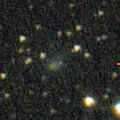
|
It brightened rapidly in outburst up to 6.9 mag (July 19, Maik Meyer). It is fading after that. Now it is .8 mag (July 21, Alan Hale). It is expected to approach to Sun down to 0.2 a.u. and brighten up to 3 mag in August. However, it may be already disintegrated. In the Northern Hemisphere, it stays observable in the morning sky until early August when the comet brightens up to 6 mag. It is not observable at all in the Southern Hemisphere.
Date(TT) R.A. (2000) Decl. Delta r Elong. m1 Best Time(A, h)
Aug. 4 7 27.18 33 8.2 0.771 0.457 25 6.0 5:25 (236,-10)
Aug. 11 8 37.19 12 48.5 0.800 0.276 11 3.9 5:19 (259, -8)
|
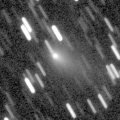
|
Now it is very bright as 8.5 mag (Aug. 7, Maik Meyer). It will brighten up to 7 mag from August to September. In the Northern Hemisphere, it will be observable in excellent condition. In the Southern Hemisphere, it will be unobservable from July to August. But it will be observable in good condition before and after that.
Date(TT) R.A. (2000) Decl. Delta r Elong. m1 Best Time(A, h)
Aug. 4 0 27.97 66 11.2 0.570 1.143 87 8.6 3:37 (180,-11)
Aug. 11 1 43.02 66 14.9 0.520 1.101 85 8.1 4:25 (180,-11)
|

|
Now it is bright as 8.8 mag (Aug. 6, Chris Wyatt). It stays bright as 8-9 mag for a while. In the Southern Hemisphere, it stays observable in good condition for a long time until the comet will fade out. In the Northern Hemisphere, it is not observable for a long time until autumn in 2019 when the comet fades out down to 16 mag.
Date(TT) R.A. (2000) Decl. Delta r Elong. m1 Best Time(A, h)
Aug. 4 15 15.78 -56 28.4 1.687 2.212 107 8.8 18:46 ( 8, 68)
Aug. 11 14 58.25 -56 57.2 1.801 2.210 99 8.9 18:51 ( 23, 65)
|
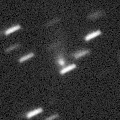
|
Now it is very bright as 9.2 mag (July 23, Chris Wyatt). In the Southern Hemisphere, it is observable from July to September, but it locates in extremely low. In the Northern Hemisphere, it is not observable until late December.
Date(TT) R.A. (2000) Decl. Delta r Elong. m1 Best Time(A, h)
Aug. 4 8 25.50 -22 21.6 1.354 0.878 40 9.1 5:25 (290, 11)
Aug. 11 9 16.61 -26 30.6 1.390 0.930 41 9.4 5:19 (297, 7)
|

|
Now it is 9.7 mag (Aug. 7, Chris Wyatt). It will go away from Earth after this, and will fade out rapidly. It stays observable in good condition until September. It locates somewhat low in the Northern Hemisphere.
Date(TT) R.A. (2000) Decl. Delta r Elong. m1 Best Time(A, h)
Aug. 4 16 58.57 -26 32.0 0.429 1.308 124 10.3 20:01 (180, 81)
Aug. 11 15 57.06 -18 17.2 0.641 1.314 102 11.2 18:51 (168, 73)
|
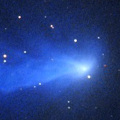
|
Now it is 11.3 mag (Aug. 1, Juan Jose Gonzalez). It stays bright as 11 mag for a long time until autumn. In the Southern Hemisphere, it is not observable for a long time after this. In the Northern Hemispehre, it stays observable for a long time until the comet fades out. But it stays very low until autumn.
Date(TT) R.A. (2000) Decl. Delta r Elong. m1 Best Time(A, h)
Aug. 4 9 30.71 52 33.9 3.516 2.758 35 11.5 18:46 (136,-28)
Aug. 11 9 53.08 52 17.4 3.520 2.784 37 11.6 18:51 (136,-29)
|

|
Now it is 11.7 mag (June 12, Juan Jose Gonzalez). It stays 12 mag for a long time until spring in 2019. In the Northern Hemisphere, it stays observable in good condition for a long time, although it becomes unobservable temporarily from mid June to August. In the Southern Hemisphere, it is not observable until September.
Date(TT) R.A. (2000) Decl. Delta r Elong. m1 Best Time(A, h)
Aug. 4 8 37.41 27 5.8 3.666 2.675 10 12.3 5:25 (250,-20)
Aug. 11 8 41.53 25 17.2 3.655 2.681 13 12.3 5:19 (250,-15)
|
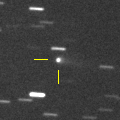
|
Now it is bright as 12.6 mag (Aug. 6, Chris Wyatt). It stays at 12-13 mag from summer to autumn. It is observable in excellent condition in the Southern Hemisphere. It locates somewhat low in the Northern Hemisphere.
Date(TT) R.A. (2000) Decl. Delta r Elong. m1 Best Time(A, h)
Aug. 4 22 43.65 -21 57.2 1.043 2.006 154 12.7 1:55 (180, 77)
Aug. 11 22 42.78 -23 24.1 1.024 2.005 159 12.6 1:27 (180, 78)
|
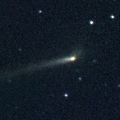
|
It brightened rapidly as predicted, and brightened up to 11.1 mag (July 13, Chris Wyatt). Now it is fading. But it is still bright as 13.2 mag (Aug. 6, Chris Wyatt). In the Southern Hemisphere, it stays observable in good condition all through this apparition. It becomes observable also in the Northern Hemisphere, but it stays low.
Date(TT) R.A. (2000) Decl. Delta r Elong. m1 Best Time(A, h)
Aug. 4 4 13.07 -34 37.0 0.265 1.025 84 12.9 5:25 (278, 65)
Aug. 11 3 25.56 -35 13.6 0.288 1.092 98 13.8 5:19 (275, 80)
|

|
Now it is 14.5 mag (July 18, Ken-ichi Kadota). It will brighten rapidly after this, and it is expected to brighten up to 9 mag from autumn to winter. In the Northern Hemisphere, it will be getting higher gradually after July. Then it stays observable in good condition for a long time until it fades out. In the Southern Hemispehre, it is observable in good condition until autumn, but it will be low in winter.
Date(TT) R.A. (2000) Decl. Delta r Elong. m1 Best Time(A, h)
Aug. 4 3 39.62 3 18.3 1.943 2.003 78 13.5 5:25 (212, 47)
Aug. 11 3 55.05 4 18.1 1.838 1.954 80 13.1 5:19 (209, 46)
|

|
Now it is 14.0 mag (Aug. 6, Chris Wyatt). Juan Jose Gonzalez reported it was bright as 12.0 mag visually on July 22.
Date(TT) R.A. (2000) Decl. Delta r Elong. m1 Best Time(A, h)
Aug. 4 23 16.22 1 34.8 4.957 5.776 140 13.2 2:28 (180, 53)
Aug. 11 23 13.97 1 30.7 4.894 5.775 147 13.2 1:58 (180, 53)
|
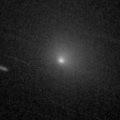
|
It brightened rapidly, and brightened up to 10.2 mag from May to June (May 22, Chris Wyatt). Now it is fading. But it is still bright as 13.0 mag (Aug. 6, Chris Wyatt).In the Southern Hemisphere, it stays observable in excellent condition. It will be getting higher gradually after this also in the Northern Hemisphere.
Date(TT) R.A. (2000) Decl. Delta r Elong. m1 Best Time(A, h)
Aug. 4 1 26.61 -16 16.7 0.917 1.634 115 13.2 4:38 (180, 71)
Aug. 11 1 24.12 -15 29.1 0.917 1.688 121 13.6 4:08 (180, 70)
|
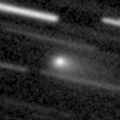
|
Now it is bright as 13.5 mag (Aug. 6, Chris Wyatt). It stays observable in good condition for a long time after this. But it will be fading gradually.
Date(TT) R.A. (2000) Decl. Delta r Elong. m1 Best Time(A, h)
Aug. 4 23 44.23 4 28.7 0.992 1.840 132 13.8 2:56 (180, 50)
Aug. 11 23 41.44 5 19.1 0.980 1.872 139 14.0 2:25 (180, 50)
|
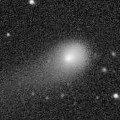
|
Now it is 12.8 mag (July 13, Seiichi Yoshida). It will be observable at 12-13 mag for a long time from 2017 to 2018. In the Southern Hemisphere, it will be hardly observable after this.
Date(TT) R.A. (2000) Decl. Delta r Elong. m1 Best Time(A, h)
Aug. 4 11 43.77 41 40.5 4.685 4.008 43 14.0 18:46 (140, -3)
Aug. 11 11 44.21 40 36.2 4.757 4.031 39 14.0 18:51 (135, -7)
|
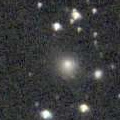
|
Now it is 14.2 mag (Aug. 1, Chris Wyatt). It stays 13-14 mag until summer in 2019. In the Northern Hemisphere, it stays observable in good condition for a while. In the Southern Hemisphere, it locates extremely low until summer.
Date(TT) R.A. (2000) Decl. Delta r Elong. m1 Best Time(A, h)
Aug. 4 16 39.21 32 17.5 3.279 3.616 101 14.2 19:47 (180, 23)
Aug. 11 16 32.31 29 32.4 3.320 3.588 97 14.2 19:13 (180, 26)
|
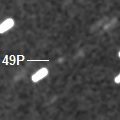
|
The condition is worst in this apparition. It brightens up to 14.5 mag from June to August, but it is not observable at all.
Date(TT) R.A. (2000) Decl. Delta r Elong. m1 Best Time(A, h)
Aug. 4 7 52.99 18 19.4 2.403 1.446 14 14.6 5:25 (252, -6)
Aug. 11 8 16.20 18 7.7 2.407 1.460 15 14.7 5:19 (252, -6)
|

|
Now it is 15.1 mag (June 18, Martin Masek). It stays 15 mag from 2018 to 2019, and it will be observable for a long time in the Southern Hemisphere. In the Northern Hemisphere, it will never be observable again.
Date(TT) R.A. (2000) Decl. Delta r Elong. m1 Best Time(A, h)
Aug. 4 12 27.06 -64 4.8 4.085 4.226 90 15.0 18:46 ( 29, 49)
Aug. 11 12 36.49 -64 8.6 4.120 4.204 87 15.0 18:51 ( 31, 47)
|
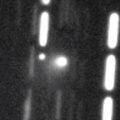
|
Now it is 14.7 mag (June 22, Toshihiko Ikemura, Hirohisa Sato). It stays at 14-15 mag for a long time from summer to winter. In the Southern Hemisphere, it stays observable in excellent condition for a while. But it will be getting lower rapidly in September, then it becomes unobservable after October. In the Northern Hemisphere, it stays observable for a long time until it fades out. But it stays extremely low.
Date(TT) R.A. (2000) Decl. Delta r Elong. m1 Best Time(A, h)
Aug. 4 14 5.15 -17 27.7 2.175 2.299 83 15.3 18:46 (125, 63)
Aug. 11 14 11.87 -15 22.5 2.224 2.243 77 15.2 18:51 (119, 57)
|

|
Now it is 16.6 mag (June 21, Kunihiro Shima). It is observable at 15 mag in 2018, in good condition in the Southern Hemisphere. It locates somewhat low in the Northern Hemisphere.
Date(TT) R.A. (2000) Decl. Delta r Elong. m1 Best Time(A, h)
Aug. 4 23 29.12 -17 3.4 2.363 3.234 143 15.3 2:41 (180, 72)
Aug. 11 23 26.26 -17 36.0 2.329 3.248 150 15.3 2:10 (180, 72)
|

|
Now it is 16.3 mag (Jan. 11, ATLAS-HKO, Haleakala). It will brighten up to 14 mag in winter. It will be observable in excellent condition in the Northern Hemisphere. In the Southern Hemisphere, it is observable only until August.
Date(TT) R.A. (2000) Decl. Delta r Elong. m1 Best Time(A, h)
Aug. 4 3 54.47 32 54.6 2.266 2.116 68 15.4 5:25 (202, 18)
Aug. 11 4 8.17 35 40.8 2.171 2.090 71 15.3 5:19 (199, 16)
|

|
It brightened up to 7.1 mag from May to June in 2017 (June 21, Juan Jose Gonzalez). Now it is fading. It has already faded down to 15.2 mag (June 18, Martin Masek). In the Southern Hemisphere, it stays observable for a long time after this. It will never be observable again in the Northern Hemisphere.
Date(TT) R.A. (2000) Decl. Delta r Elong. m1 Best Time(A, h)
Aug. 4 2 9.51 -49 27.8 4.575 5.021 110 15.6 5:20 ( 0, 76)
Aug. 11 2 8.90 -50 21.6 4.595 5.083 113 15.7 4:52 ( 0, 75)
|
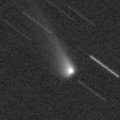
|
Now it is 16.8 mag (Aug. 5, Toshihiko Ikemura, Hirohisa Sato). Fading now. It stays observable in good condition for a long time after this in the Southern Hemisphere. It stays low in the Northern Hemisphere.
Date(TT) R.A. (2000) Decl. Delta r Elong. m1 Best Time(A, h)
Aug. 4 0 44.03 -22 41.1 3.996 4.669 126 15.7 3:55 (180, 78)
Aug. 11 0 37.95 -24 40.2 3.939 4.692 133 15.7 3:22 (180, 80)
|

|
Now it is 15.9 mag (July 14, iTelescope Observatory, Siding Spring). It will brighten up to 12 mag in autumn in 2019. It stays observable in good condition for a while in the Southern Hemisphere. It will become observable after August also in the Northern Hemisphere. But it stays extremely low for a long time.
Date(TT) R.A. (2000) Decl. Delta r Elong. m1 Best Time(A, h)
Aug. 4 3 13.95 -42 24.0 4.752 5.000 98 15.9 5:25 (307, 76)
Aug. 11 3 13.69 -42 57.2 4.642 4.952 101 15.8 5:19 (320, 79)
|

|
Now it is around the apheilon. But it brightened up to 15.8 mag in outburst (July 21, Hidetaka Sato). Now it is getting diffused. But it is bright as 16.1 mag still now (Aug. 5, Toshihiko Ikemura, Hirohisa Sato).
Date(TT) R.A. (2000) Decl. Delta r Elong. m1 Best Time(A, h)
Aug. 4 21 15.97 -12 24.8 3.629 4.638 172 16.0 0:28 (180, 67)
Aug. 11 21 11.98 -12 44.9 3.625 4.637 176 16.1 23:52 (180, 68)
|

|
Now it is 17.6 mag (Aug. 5, Toshihiko Ikemura, Hirohisa Sato). It will approach to Earth down to 0.08 a.u. in December, and it is expected to brighten up to 3 mag. In the Northern Hemisphere, it stays observable in excellent condition. In the Southern Hemisphere, it is observable in good condition until mid December when it brightens up to 3 mag. But it becomes unobservable after that.
Date(TT) R.A. (2000) Decl. Delta r Elong. m1 Best Time(A, h)
Aug. 4 1 0.22 -14 11.7 1.173 1.908 121 16.5 4:11 (180, 69)
Aug. 11 1 8.90 -14 52.3 1.066 1.848 125 16.0 3:52 (180, 70)
|
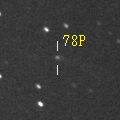
|
Now it is 16.4 mag (July 15, Toshihiko Ikemura, Hirohisa Sato). It stays at 13 mag for a long time from winter to autumn in 2019. It stays observable in good condition until winter when the comet brightens up to 13 mag.
Date(TT) R.A. (2000) Decl. Delta r Elong. m1 Best Time(A, h)
Aug. 4 21 53.56 -3 13.1 1.762 2.736 159 16.3 1:05 (180, 58)
Aug. 11 21 48.88 -3 34.5 1.709 2.705 166 16.1 0:33 (180, 58)
|
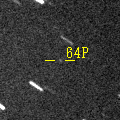
|
Now it is 17.8 mag (July 15, Toshihiko Ikemura, Hirohisa Sato). It was expected to brighten rapidly up to 10 mag in autumn. But actually, it is much fainter than expected. It will be observable in excellent condition in the Northern Hemisphere. It stays low in the Southern Hemisphere.
Date(TT) R.A. (2000) Decl. Delta r Elong. m1 Best Time(A, h)
Aug. 4 23 55.96 10 20.6 0.947 1.759 127 16.6 3:07 (180, 45)
Aug. 11 0 2.44 12 42.8 0.865 1.713 131 16.2 2:46 (180, 42)
|
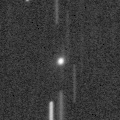
|
It brightened rapidly. Now it is 16.1 mag (Aug. 5, Toshihiko Ikemura, Hirohisa Sato). It will be fading after this, and will be fainter than 18 mag in September.
Date(TT) R.A. (2000) Decl. Delta r Elong. m1 Best Time(A, h)
Aug. 4 15 19.57 -7 18.6 1.705 2.102 97 16.3 18:46 (171, 62)
Aug. 11 15 28.55 -10 24.3 1.803 2.134 94 16.5 18:51 (157, 64)
|
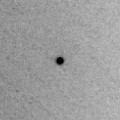
|
Now it is 16.2 mag (June 17, Jean-Francois Soulier). It stays 16 mag for a while. In the Southern Hemisphere, it stays observable until August, but it will be unobservable after that. In the Northern Hemisphere, it becomes observable in good condition after this. Its cometary activity was observed on Mar. 26 (M. Mommert, D. Polishook, N. Moskovitz).
Date(TT) R.A. (2000) Decl. Delta r Elong. m1 Best Time(A, h)
Aug. 4 2 47.60 30 26.6 1.445 1.660 82 16.4 5:25 (188, 24)
Aug. 11 2 53.82 33 37.1 1.433 1.714 87 16.4 5:19 (184, 21)
|
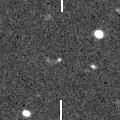
|
Now it is 17.0 mag (July 15, Toshihiko Ikemura, Hirohisa Sato). It brightens up to 16 mag from August to October. But it stays low.
Date(TT) R.A. (2000) Decl. Delta r Elong. m1 Best Time(A, h)
Aug. 4 12 49.24 3 32.7 1.793 1.539 58 16.6 18:46 (125, 35)
Aug. 11 13 7.60 1 38.1 1.818 1.530 57 16.4 18:51 (121, 34)
|
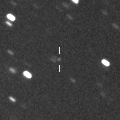
|
Now it is 17.3 mag (July 15, Toshihiko Ikemura, Hirohisa Sato). It will be observable at 16.5 mag in good condition from August to September.
Date(TT) R.A. (2000) Decl. Delta r Elong. m1 Best Time(A, h)
Aug. 4 21 44.85 -4 26.8 1.285 2.272 162 16.9 0:57 (180, 59)
Aug. 11 21 40.98 -4 34.0 1.239 2.241 168 16.7 0:25 (180, 59)
|
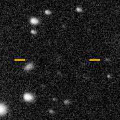
|
It will be observable at 16 mag in good condition from autumn to winter. It locates somewhat low in the Southern Hemisphere.
Date(TT) R.A. (2000) Decl. Delta r Elong. m1 Best Time(A, h)
Aug. 4 5 35.59 30 13.6 2.956 2.383 47 16.9 5:25 (222, 9)
Aug. 11 5 50.95 30 19.9 2.890 2.376 50 16.8 5:19 (221, 10)
|
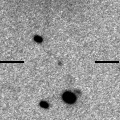
|
It is expected to brighten up to 7-8 mag in 2020. It is already observable in good condition in the Southern Hemisphere. It will become observable in good condition also in the Northern Hemisphere.
Date(TT) R.A. (2000) Decl. Delta r Elong. m1 Best Time(A, h)
Aug. 4 3 58.13 -3 38.3 7.086 6.914 76 17.1 5:25 (223, 50)
Aug. 11 3 59.83 -3 42.5 6.926 6.857 81 17.1 5:19 (217, 53)
|
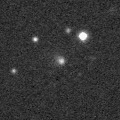
|
It brightened rapidly, and brightened up to 16.0 mag in spring (Apr. 14,Catalina Sky Survey). Now it is fading slowly. It has already faded down to 17.9 mag (July 14, Toshihiko Ikemura, Hirohisa Sato). It will be getting low after this.
Date(TT) R.A. (2000) Decl. Delta r Elong. m1 Best Time(A, h)
Aug. 4 13 49.66 -4 29.2 2.041 2.045 75 17.1 18:46 (135, 51)
Aug. 11 14 2.27 -5 32.7 2.107 2.045 72 17.2 18:51 (128, 49)
|

|
Now it is 17.1 mag (June 13, Toshihiko Ikemura, Hirohisa Sato). It will be fading gradually after this, and it will be fainter than 18 mag in winter. In the Northern Hemisphere, it stays observable in good condition for a long time. In the Southern Hemisphere, it will never be observable again.
Date(TT) R.A. (2000) Decl. Delta r Elong. m1 Best Time(A, h)
Aug. 4 23 44.79 77 3.5 7.521 7.454 82 17.1 2:56 (180,-22)
Aug. 11 23 40.42 77 24.9 7.498 7.479 85 17.1 2:24 (180,-23)
|

|
Now it is 17.3 mag (Feb. 20, Toshihiko Ikemura, Hirohisa Sato). It stays 17 mag in 2018.
Date(TT) R.A. (2000) Decl. Delta r Elong. m1 Best Time(A, h)
Aug. 4 4 59.24 5 28.1 7.850 7.376 58 17.2 5:25 (232, 34)
Aug. 11 5 2.36 5 18.1 7.790 7.409 64 17.2 5:19 (228, 37)
|
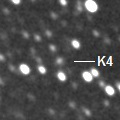
|
Now it is 17.6 mag (July 15, Toshihiko Ikemura, Hirohisa Sato). It was observed at 16 mag from summer to autumn in 2017. It will be observable at 17 mag in good condition also in 2018. It locates somewhat low in the Southern Hemisphere.
Date(TT) R.A. (2000) Decl. Delta r Elong. m1 Best Time(A, h)
Aug. 4 1 10.82 26 53.5 2.952 3.343 103 17.2 4:22 (180, 28)
Aug. 11 1 11.92 27 43.7 2.907 3.384 109 17.2 3:56 (180, 27)
|

|
Now it is 17.1 mag (July 13, Toshihiko Ikemura, Hirohisa Sato). It stays 17 mag until August. It is observable in good condition in the Northern Hemisphere. It will be getting low and becom unobservable soon in the Southern Hemisphere.
Date(TT) R.A. (2000) Decl. Delta r Elong. m1 Best Time(A, h)
Aug. 4 3 23.93 42 40.5 1.237 1.353 73 17.3 5:25 (193, 11)
Aug. 11 3 47.09 47 30.8 1.252 1.384 74 17.4 5:19 (192, 6)
|
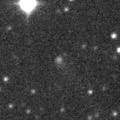
|
Now it is 16.9 mag (May 15, Toshihiko Ikemura, Hirohisa Sato). It will be fainter than 18 mag in summer.
Date(TT) R.A. (2000) Decl. Delta r Elong. m1 Best Time(A, h)
Aug. 4 14 29.48 -2 40.6 6.655 6.639 84 17.3 18:46 (150, 54)
Aug. 11 14 31.20 -2 30.0 6.789 6.661 78 17.4 18:51 (139, 50)
|

|
First return of a new periodic comet which brightened up to 16.5 mag in 2005. Now it is 19.1 mag (June 14, E. Schwab, D. Abreu). It will be observable at 17 mag in good condition in autumn. It locates low in the Southern Hemisphere.
Date(TT) R.A. (2000) Decl. Delta r Elong. m1 Best Time(A, h)
Aug. 4 1 17.59 29 14.3 1.653 2.104 101 17.8 4:29 (180, 26)
Aug. 11 1 26.50 30 40.2 1.583 2.093 105 17.7 4:10 (180, 24)
|

|
First return of a new periodic comet which brightened up to 17 mag in 2008. It was predicted to brighten up to 18 mag in autumn. But actually, it is much fainter than predicted, fainter than 21.5 mag (June 22, Erwin Schwab).
Date(TT) R.A. (2000) Decl. Delta r Elong. m1 Best Time(A, h)
Aug. 4 23 23.70 -0 16.6 2.994 3.824 139 17.9 2:35 (180, 55)
Aug. 11 23 21.04 -0 15.8 2.933 3.823 146 17.9 2:05 (180, 55)
|
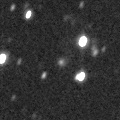
|
It is expected to be observable at 5-6 mag for a long time from 2022 to 2023. It will be observable in good condition for a long time in the Southern Hemisphere. In the Northern Hemisphere, it is not observable at the highlight from 2022 summer to 2023 summer.
Date(TT) R.A. (2000) Decl. Delta r Elong. m1 Best Time(A, h)
Aug. 4 17 14.72 60 20.1 13.432 13.481 90 17.9 20:22 (180, -5)
Aug. 11 17 12.44 59 51.5 13.405 13.438 89 17.9 19:53 (180, -5)
|
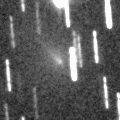
|
Now it is 17.2 mag (June 21, Kunihiro Shima). It is observable in good condition after this in the Southern Hemisphere. But it stays low in the Northern Hemisphere.
Date(TT) R.A. (2000) Decl. Delta r Elong. m1 Best Time(A, h)
Aug. 4 17 22.43 -43 59.4 1.826 2.580 128 17.9 20:30 ( 0, 81)
Aug. 11 17 2.71 -43 11.1 2.007 2.648 118 18.2 19:43 ( 0, 82)
|
|
![]()
 C/2016 R2 ( PanSTARRS )
C/2016 R2 ( PanSTARRS ) C/2016 N6 ( PanSTARRS )
C/2016 N6 ( PanSTARRS ) 48P/Johnson
48P/Johnson 364P/2018 A2 ( PanSTARRS )
364P/2018 A2 ( PanSTARRS ) 38P/Stephan-Oterma
38P/Stephan-Oterma 29P/Schwassmann-Wachmann 1
29P/Schwassmann-Wachmann 1 66P/du Toit
66P/du Toit 37P/Forbes
37P/Forbes C/2015 O1 ( PanSTARRS )
C/2015 O1 ( PanSTARRS ) C/2017 M4 ( ATLAS )
C/2017 M4 ( ATLAS ) 49P/Arend-Rigaux
49P/Arend-Rigaux C/2017 B3 ( LINEAR )
C/2017 B3 ( LINEAR ) C/2018 L2 ( ATLAS )
C/2018 L2 ( ATLAS ) 65P/Gunn
65P/Gunn (944) Hidalgo
(944) Hidalgo C/2015 V2 ( Johnson )
C/2015 V2 ( Johnson ) C/2015 V1 ( PanSTARRS )
C/2015 V1 ( PanSTARRS ) C/2018 N2 ( ASASSN )
C/2018 N2 ( ASASSN ) 129P/Shoemaker-Levy 3
129P/Shoemaker-Levy 3 46P/Wirtanen
46P/Wirtanen 78P/Gehrels 2
78P/Gehrels 2 64P/Swift-Gehrels
64P/Swift-Gehrels C/2018 C2 ( Lemmon )
C/2018 C2 ( Lemmon ) (3552) Don Quixote
(3552) Don Quixote 125P/Spacewatch
125P/Spacewatch 137P/Shoemaker-Levy 2
137P/Shoemaker-Levy 2 59P/Kearns-Kwee
59P/Kearns-Kwee C/2017 T2 ( PanSTARRS )
C/2017 T2 ( PanSTARRS ) 105P/Singer Brewster
105P/Singer Brewster C/2014 OE4 ( PanSTARRS )
C/2014 OE4 ( PanSTARRS ) C/2011 KP36 ( Spacewatch )
C/2011 KP36 ( Spacewatch ) C/2017 K4 ( ATLAS )
C/2017 K4 ( ATLAS ) C/2018 M1 ( Catalina )
C/2018 M1 ( Catalina ) C/2017 E3 ( PanSTARRS )
C/2017 E3 ( PanSTARRS ) P/2018 L3 ( NEAT )
P/2018 L3 ( NEAT ) P/2008 O2 ( McNaught )
P/2008 O2 ( McNaught ) C/2017 K2 ( PanSTARRS )
C/2017 K2 ( PanSTARRS ) C/2017 S6 ( Catalina )
C/2017 S6 ( Catalina )![]()

































